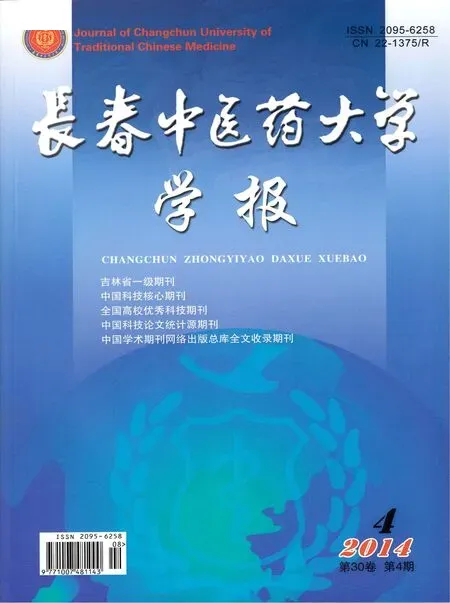A型利钠肽与焦虑障碍相关性分析
2014-03-25,,,
, , ,
(1.成都市武侯区望江路社区卫生服务中心,成都 610041;2.成都中医药大学,成都 610075;3.成都中医药大学附属医院,成都 610072)
A型利钠肽与焦虑障碍相关性分析
王旭1,何薇2,王强2,雷鸣3*
(1.成都市武侯区望江路社区卫生服务中心,成都 610041;2.成都中医药大学,成都 610075;3.成都中医药大学附属医院,成都 610072)
现代研究提示,利钠肽是一种具有抗焦虑、抗恐慌等情绪疾病的神经调节剂,其中A型利钠肽最为重要。心脏方面,焦虑障碍患者中血浆ANP水平往往低于正常,增加其含量则可达到抗焦虑作用;中枢方面,焦虑障碍发生时HPA轴功能亢进,而A型利钠肽对HPA轴有良性的调节作用。推测A型利钠肽及其受体的功能异常可能是焦虑障碍发病的重要机制之一。探索这一机制有助于进一步完善焦虑障碍的病理生理机制。
A型利钠肽;焦虑障碍;神经调节剂;抗焦虑
焦虑障碍(anxiety disorder)是对没有明确客观对象而表现出持续性紧张、焦虑、失眠或反复发作的惊恐不安等为主要特征的一组症候群,是临床最常见的精神类疾病之一[1]。研究显示,焦虑障碍的发病呈逐年增加趋势,并可持续终生,甚至导致自杀等严重后果产生[2]。2012年美国青少年流行病学调查提示焦虑障碍的人群归因危险度达10.9%,仅次于行为障碍、抑郁障碍,位居第3[3]。笔者通过查阅文献后发现,心、脑利钠肽的变化与焦虑障碍的发生有关,现分析如下。
1 心脏A型利钠肽系统与焦虑障碍相关性研究
现代研究认识到,心脏不仅是一个循环系统的器官,亦是一个存在内分泌系统的器官,能合成并分泌房钠肽、血管紧张素、心肌生长因子等多种激素。利钠肽系统主要包括A-型利钠肽(ANP)、脑利钠肽(BNP)、C-型利钠肽(CNP)及其受体A型(NPRA)、B型(NPRB)、C型(NPRC)[4]。其中NPR-A主要与ANP,BNP结合,且与ANP的亲和力远比BNP强;NPR-B主要结合CNP;NPR-C则可结合所有的利钠肽,被认为是利钠肽的清除受体[5]。
心脏利钠肽系统研究表明,ANP与NPR-A受体结合,通过G蛋白激活与其偶联的鸟苷酸环化酶,促进细胞内cGMP即靶细胞的第二信使的生成,发挥调节体液内稳态、血压等作用,同时还具有治疗焦虑障碍的潜能。如恐慌症患者显示血浆ANP水平较低,相比对照组更易诱导实验性恐慌发作,而增加ANP含量,恐慌患者焦虑被改善,故推测心房利钠肽受体激动剂可能是潜在的抗恐慌和抗焦虑的一类新型心理治疗药物[6]。相比正常人群,创伤后应激障碍(PTSD)患者的血浆ANP水平测试结果明显更低[7]。另实验研究表明,有氧运动后可减轻胆囊收缩素四肽(CCK-4)诱发的惊恐、焦虑症状,同时又伴有血清中ANP浓度水平的上升,提示有氧运动可能是通过调节ANP浓度发挥抗焦虑作用[8]。
从上得知,A型利钠肽系统与焦虑障碍有密切关系,ANP浓度水平与患者是否焦虑直接呈相反的关系,增加ANP的含量或使用心房利钠肽受体激动剂可治疗焦虑障碍。
2 脑中A型利钠肽系统与焦虑障碍相关性研究
脑中的利钠肽系统并不是来源于外周循环系统,由于分子量较大,ANP难于通过血脑屏障和脑脊液屏障,故心脏和大脑分别独立存在利钠肽系统[9]。中枢神经系统(CNS)的ANP直接由CNS中的ANP神经元合成分泌,研究[10]证实,脑组织中广泛分布着利钠肽及其整个受体系统,其中ANP及其受体NPRA主要分布在皮层、海马、下丘脑等部位,不仅发挥调节体内平衡,维持内环境稳态等作用,还直接影响情感行为,比如焦虑、恐慌、应激激素释放的后遗症和自主神经系统激活等[11]。A型利钠肽与受体结合可以抑制焦虑障碍患者激活的下丘脑—垂体—肾上腺(HPA)轴[12],从而发挥治疗焦虑障碍的作用。研究进一步证实,该治疗效应是因为ANP作为一种激素的反馈信号分子,无论在人和啮齿类动物均可以削弱下丘脑促肾上腺皮质激素释放激素(CRH)的释放,从而抑制由应激导致激活的HPA的活性[13]。恐慌焦虑患者易伴随的ACTH和皮质醇分泌过甚,给予恐慌患者侧脑室或者静脉注入ANP便可缓解恐慌患者的恐慌焦虑发作[11]。
3 结语
综上所述,心与脑中的A型利钠肽可能是参与中枢神经系统与心脏调节作用的重要激素,心脏方面,焦虑障碍发生时机体血浆ANP低于正常,增加ANP含量则治疗焦虑;中枢方面,焦虑障碍发生时HPA轴功能亢进,而A型利钠肽对HPA轴有不同的调节作用,因此不难得出结论:焦虑障碍发病的重要机制之一是A型利钠肽及其受体的功能异常,这一机制的探索有助于进一步完善焦虑障碍的病理生理机制,为临床解决焦虑障碍这一世界性难题提供新的治疗途径和研究思路。
[1]Danielsson L,Scherman M H,Rosberg S.To sense and make sense of anxiety:Physiotherapists’ perceptions of their treatment for patients with generalized anxiety[J].Physiother Theory Pract,2013,29(8):604-615.
[2]Sherbourne C D,Sullivan G,Craske M G,et al.Functioning and disability levels in primary care out-patients with one or more anxiety disorders[J].Psychol Med,2010,40(12):2059-2068.
[3]Kessler R C,Avenevoli S,Costello J,et al.Severity of 12-Month DSM-IV disorders in the National comorbidity survey replication adolescent supplement[J].Arch Gen Psychiatry,2012,69(4):381-389.
[4]Chopra S,Cherian D,Verghese P P,et al.Physiology and clinical significance of natriuretic hormones[J].Indian J Endocrinol Metab,2013,17(1):83-90.
[5]金强,李卫鹏.钠尿肽家族研究进展[J].东南大学学报:医学版,2006,25(4):312-314.
[6]Kellner M,Jahn H,Wiedemann K.Natriuretic peptides and panic disorder:therapeutic prospects[J].Expert Rev Neurother,2003,3(3):381-386.
[7]Kellner M,Yassouridis A,Hübner R,et al.Endocrine and cardiovascular responses to corticotropin-releasing hormone in patients with posttraumatic stress disorder:a role for atrial natriuretic peptide[J].Neuropsychobiology,2003,47(2):102-108.
[8]Strøhle A,Feller C,J Strasburger C,et al.Anxiety modulation by the heart Aerobic exercise and atrial natriuretic peptide[J].Psychoneuroendocrinology,2006,31(9):1127-1130.
[9]Chenevier-Gobeaux C,Delerme S,Allo J C,et al.B-type natriuretic peptides for the diagnosis of congestive heart failure in dyspneic oldest-old patients[J].Clinical biochemistry,2008,41(13):1049-1054.
[10]Cao L H,Yang X L.Natriuretic peptides and their receptors in the central nervous system[J].Prog Neurobiol,2008,84(3):234-248.
[11]Wiedemann K,Jahn H,Kellner M.Effects of natriuretic peptides upon hypothalamo-pituitary-adrenocortical system activity and anxiety behaviour[J].Exp Clin Endocrinol Diabetes,2000,108(1):5-13.
[12]Porzionato A,Macchi V,Rucinski M,et al.Natriuretic peptides in the regulation of the hypothalamic-pituitary-adrenal axis[J].International review of cell and molecular biology,2010,280:1-39.
[13]Jahn H,Montkowski A,Knaudt K,et al.Alpha-helical-corticotropin-releasing hormone reverses anxiogenic effects of C-type natriuretic peptide in rats[J].Brain Res,2001,893(1/2):21-28.
CorrelationanalysisofAtypenatriureticpeptideandanxietydisorders
WANG Xu1,HE Wei2,WANG Qiang2,LEI Ming3*
(1.Wuhou District Wangjiang Road Community Health Service Centers,Chengdu 610041,China;2.Chengdu University of TCM,Chengdu 610075,China;3.The Affiliated Hospital of Chengdu University of TCM,Chengdu 610072,China)
Recent studies indicated that natriuretic peptide is a kind of antipanic and anxiolytic neuroregulator,especially the A type natriuretic peptide.In cardiovascular system,the levels of ANP in plasma of patients with anxiety disorders are often lower than normal,but the increase of ANP level can reach anti-anxiety effect; In central nervous system,HPA axis becomes overactive while anxiety disorders occur,A type natriuretic peptide can paly a role of benignly adjust the HPA axis’ function.It is easy to infer that one of the important mechanism of anxiety disorder perhaps is the dysfunction of A type natriuretic peptide and its receptor.The exploration of the mechanism will be good for further improving the physiopathologic mechanism of anxiety disorders.
A type natriuretic peptide;anxiety disorder;neuroregulator;antianxiety
10.13463/j.cnki.cczyy.2014.04.063
国家自然科学基金项目(81173322)。
王 旭(1977-),男,医师。研究方向:内科临床。
] 雷 鸣,主任医师,电子信箱:minglei2828@163.com。
R256.28
:A
:2095-6258(2014)04-0726-03
2014-03-26)
*[
